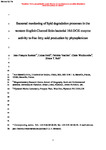Seasonal monitoring of lipid degradation processes in the western English Channel links bacterial 10S-DOX enzyme activity to free fatty acid production by phytoplankton
| dc.contributor.author | Rontani, J-F | |
| dc.contributor.author | Smik, L | |
| dc.contributor.author | Vaultier, F | |
| dc.contributor.author | Widdicombe, C | |
| dc.contributor.author | Belt, Simon | |
| dc.date.accessioned | 2021-01-27T14:31:20Z | |
| dc.date.issued | 2021-01-23 | |
| dc.identifier.issn | 0304-4203 | |
| dc.identifier.issn | 1872-7581 | |
| dc.identifier.other | 103928 | |
| dc.identifier.uri | http://hdl.handle.net/10026.1/16822 | |
| dc.description | 18 month embargo applies. | |
| dc.description.abstract |
In a few recent studies, the action of a bacterial dioxygenase (10S-DOX) on palmitoleic acid was observed within some polar and estuarine settings. To add further mechanistic information regarding the action of this enzyme in marine settings, we measured a range of lipids (sterols, fatty acids and the chlorophyll phytyl side chain) and their biotic and abiotic degradation products in water samples collected in 2018 from two depths (5 m and 25 m) at the temperate oceanographic time series site L4, located in the western English Channel. Lipid distributions indicated a dominance of diatoms and copepods during the spring bloom, while a peak in dinoflagellate activity was evident in samples collected from late summer/autumn, both outcomes being consistent with taxonomic data reported previously for the same sampling site and interval. Monitoring of lipid oxidation products characteristic of different degradation pathways showed a relatively weak effect of photo- and autoxidation processes, with these acting mainly on the more reactive lipids (i.e. chlorophyll and polyunsaturated fatty acids). In contrast, monitoring of biotic degradation processes revealed significant quantities of 10S-hydroxyhexadec-8(E)-enoic acid in samples collected at the end of April (reaching 40% of the residual parent palmitoleic acid), attributed to the involvement of bacterial 10-dioxygenase (10S-DOX) activity during the spring bloom. We propose that this enzyme could be utilised by bacteria to detoxify free fatty acids released by wounded diatoms in the presence of copepods | |
| dc.format.extent | 103928-103928 | |
| dc.language | en | |
| dc.language.iso | en | |
| dc.publisher | Elsevier BV | |
| dc.subject | Biotic and abiotic degradation | |
| dc.subject | 10S-DOX enzymatic activity | |
| dc.subject | Bacteria | |
| dc.subject | Wounded diatoms | |
| dc.title | Seasonal monitoring of lipid degradation processes in the western English Channel links bacterial 10S-DOX enzyme activity to free fatty acid production by phytoplankton | |
| dc.type | journal-article | |
| dc.type | Journal Article | |
| plymouth.author-url | https://www.webofscience.com/api/gateway?GWVersion=2&SrcApp=PARTNER_APP&SrcAuth=LinksAMR&KeyUT=WOS:000632920400003&DestLinkType=FullRecord&DestApp=ALL_WOS&UsrCustomerID=11bb513d99f797142bcfeffcc58ea008 | |
| plymouth.volume | 230 | |
| plymouth.publication-status | Published | |
| plymouth.journal | Marine Chemistry | |
| dc.identifier.doi | 10.1016/j.marchem.2021.103928 | |
| plymouth.organisational-group | /Plymouth | |
| plymouth.organisational-group | /Plymouth/Faculty of Science and Engineering | |
| plymouth.organisational-group | /Plymouth/REF 2021 Researchers by UoA | |
| plymouth.organisational-group | /Plymouth/REF 2021 Researchers by UoA/UoA07 Earth Systems and Environmental Sciences | |
| plymouth.organisational-group | /Plymouth/Research Groups | |
| plymouth.organisational-group | /Plymouth/Research Groups/Marine Institute | |
| plymouth.organisational-group | /Plymouth/Users by role | |
| plymouth.organisational-group | /Plymouth/Users by role/Academics | |
| plymouth.organisational-group | /Plymouth/Users by role/Researchers in ResearchFish submission | |
| dcterms.dateAccepted | 2021-01-09 | |
| dc.rights.embargodate | 2022-7-23 | |
| dc.identifier.eissn | 1872-7581 | |
| dc.rights.embargoperiod | Not known | |
| rioxxterms.versionofrecord | 10.1016/j.marchem.2021.103928 | |
| rioxxterms.licenseref.uri | http://www.rioxx.net/licenses/all-rights-reserved | |
| rioxxterms.licenseref.startdate | 2021-01-23 | |
| rioxxterms.type | Journal Article/Review |


